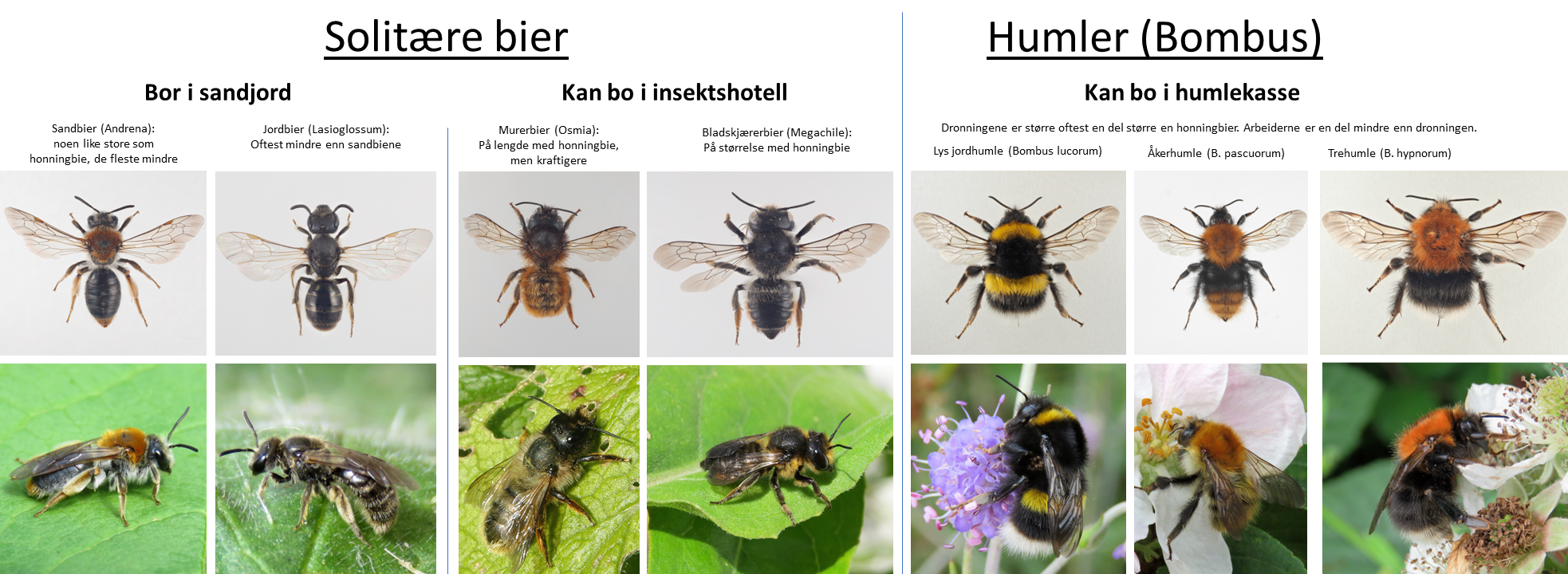Sex
1. Antenna has 12 segments (flagellum with 10) female
- Antenna has 13 segments (flagellum with 11) male
Females
1. Forewing with two submarginal cells (Fig. 1A/B) 2
- Forewing with three submarginal cells (Fig. 1C/D) 5
2. Underside of abdomen with densely haired pollen brush (fig xA), with hairs usually longer than the length of a sternite. cavity nesting bee
- Underside of abdomen without a pollen brush, with most or all hairs shorter than the length of a sternite. 3
3. Hind tibiae and basitarsi normally with an obvious dense pollen brush (pic) ground nesting bee
- Hind legs and underside of abdomen missing dense pollen brush. Hind legs with short or sparse hairs and underside of abdomen with inconspicuous hairs or with dense patches of adpressed white hairs. 4
4. Face virtually free of hairs with distinct
yellow or whitish markings (pic) Hylaeus (cavity nesting bee)
- Face hairy and without yellow/ whitish surface markings parasite on cavity nesting bees
(eyes hairy + triangular pointy abdomen = Coelioxys, else = Stelis)
5. Very distinct and large. Dark, metallic blue/purple body and wings Xylocopa
(cavity nesting solitary, non-native bee. Only a few observations in Norway since 2019)
- Not as described above 6
6. Eyes hairy. Long marginal cell and
third submarginal cell long and tilted downwards Apis mellifera
- Eyes not hairy. Forewings with shorter marginal cell,
and third sub-marginal cell not tilted downwards. 7
7. Plump, furry and mostly large (except some workers of Bombus pratorum).
Sub-marginal cells more or less similar surface area/size. 8
- Not as described above. 9
8. Has a cheek area separating the eye and the jaw.
1st submarginal cell partly divided by a very weak vertical vein (pic). Bombus
- No cheek area between eye and jaw.
Tibia and basitarsus with a yellow-ish pollenbrush on outer face.
2m-cu entering the third submarginal cell in lower outer corner of the cell. Antophora
(cavity nesting solitary bee, most likely Antophora furcate)
9. Hind tibiae and basitarsi normally with an
obvious dense pollen brush (pic) ground nesting bee
- Hind legs and underside of abdomen missing dense pollen brush.
Hind legs with short or sparse hairs parasite on ground nesting bees
Males
1. Forewing with two submarginal cells (Fig xA/B) 2
- Forewing with three submarginal cells (fig xC/D 10
2. Surface of face and/or legs with yellow or whitish markings,
Tarsi never expanded (fig. x) 3
- Ground colour of face and legs entirely dark, except for front legs of two Megachile species, with whitish, expanded tarsi (fig. x) 4
3. Antenna longer than wings (Eucera longicornis) or
swollen hind legs and yellow surface on lower part of face (Macropis europaea)
neither registered in Vestland Ground nesting bee
- Above description doesn’t fit Cavity nesting bee
4. Eyes hairy,
characteristic spikes at tip (T6) of abdomen Coelioxys; Parasitic cavity nesting bee
- Above description doesn’t fit 5
5. Second medial cell at most slightly longer than wide (fig xC).
Dufourea; Ground nesting bee
- Second medial cell minimum 1.5 times as long as wide (fig xD) 6
6. Tarsi without an arolium between the claws (pic). Megachile; Cavity nesting bee
- Tarsi with arolium between claws 7
7. Second segment of underside of abdomen (S2) with a large projection,
and/or last antennal segment bent and claw-like Hoplitis; Cavity nesting bee
- Above description does not fit 8
8. Wing vein 2m-cu meeting basal vein
just beyond the end of the second submarginal cell (fig x)
Stelis; Parasitiv cavity nesting bee
- Wing vein 2m-cu meeting the second submarginal cell
before the end of that cell (fig xA and B) 9
9. Mandibles longer than the length of an eye, face wider than high,
antennae short, with most segments wider than long (Panurgus) or
Vein 2m-cu entering second submarginal cell ca. in the middle of the cell,
very rare (VU) and not registered in Vestland (Dasypoda hirtipes) Ground nesting bee
- Above descriptions doesn’t fit Cavity nesting bee
10. Eyes hairy and meeting at top of head. Long marginal cell and
third submarginal cell long and tilted downwards Apis mellifera
- Eyes bare, not meeting on top. Wing not as above 11
11. Third submarginal cell with the internal area
clearly greater than the second submarginal cell (fig xC) 12
- Third submarginal cell with internal area ca. equal or
less than the second submarginal cell 14
12. Surface of tergites (overside of abdomen) usually red
outer antennal segments rounded,
often with patches of small withish hairs Spechodes; parasitic ground nesting bee
- Above description does not fit, but if tergites are red
also with patches of whitish hairs and yellow markings on face 13
13. Very distinct and large. Dark, metallic blue/purple body and wings Xylocopa
(cavity nesting solitary, non-native bee. A few observations in Norway since 2019)
- Above description does not fit ground nesting bee
14. Small wasp-like bees. Not furry. Tip of abdomen with prominent pygdium
Abdomen often with yellow,
red or brownish patches. Parasitic ground nesting bee
- Above description does not fit 15
15. Smaller, less furry. 2m-cu vein bending inwards where it meets the basal vein.
First submarginal cell longer, and often twice as large area
as the second and third (fig xA) Colletes; ground nesting bee
- Large, furry bees. 2m-cu vein not bending inwards as above (fig xB/C)
First submarginal cell about equal in area as second and third.
Surface of legs entirely dark beneath hairs. Bumblebee-like. 16
16. Surface of face entirely black. 2m-cu vein entering the third submarginal
cell before the end of that cell (fig xB). Very furry. Bombus
- Surface of face extensively yellow beneath hairs.
2m-cu vein entering the third submarginal cell in the lower corner
of the cell (fig xC/D). Less furry. Anthophora; Cavity nesting bee

